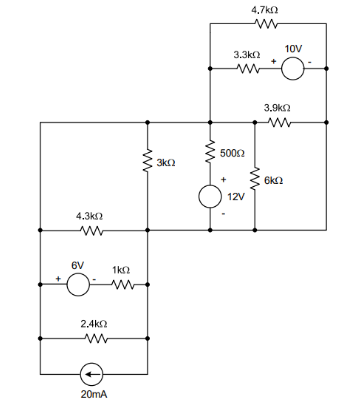For the circuit shown below find the number of essential nodes, the number of special cases for the node voltage method, and the number of equations to be solved using the node voltage method (reduced by the number of special cases, if applicable). Find the number of meshes, the number of special cases when using the mesh current method, and the number of equations to be solved in the mesh current method (reduced by the number of special cases, if applicable). Determine whether the node voltage method or the mesh current method will be more efficient. (You do not need to solve.) 4.3ΚΩ www 6V 1 ΚΩ www 2.4ΚΩ ww 20mA www 3ΚΩ 3.3ΚΩ 500Ω 4.7ΚΩ 12V www 10V 3.9ΚΩ 6KQ
For the circuit shown below find the number of essential nodes, the number of special cases for the node voltage method, and the number of equations to be solved using the node voltage method (reduced by the number of special cases, if applicable). Find the number of meshes, the number of special cases when using the mesh current method, and the number of equations to be solved in the mesh current method (reduced by the number of special cases, if applicable). Determine whether the node voltage method or the mesh current method will be more efficient. (You do not need to solve.) 4.3ΚΩ www 6V 1 ΚΩ www 2.4ΚΩ ww 20mA www 3ΚΩ 3.3ΚΩ 500Ω 4.7ΚΩ 12V www 10V 3.9ΚΩ 6KQ
Introductory Circuit Analysis (13th Edition)
13th Edition
ISBN:9780133923605
Author:Robert L. Boylestad
Publisher:Robert L. Boylestad
Chapter1: Introduction
Section: Chapter Questions
Problem 1P: Visit your local library (at school or home) and describe the extent to which it provides literature...
Related questions
Question
Use Mesh Current Method

Transcribed Image Text:**Circuit Analysis Challenge**
In this problem, you are given a circuit and tasked with analyzing it using both the node voltage method and the mesh current method. Your objectives are as follows:
1. **Node Voltage Method**:
- Determine the number of essential nodes in the circuit.
- Identify any special cases applicable within this method.
- Calculate the number of equations necessary to solve the circuit using this method, reducing the number if special cases apply.
2. **Mesh Current Method**:
- Find the total number of meshes in the circuit.
- Identify any special cases applicable within this method.
- Calculate the number of equations necessary to solve the circuit using this method, reducing the number if special cases apply.
3. **Method Efficiency**:
- Evaluate and determine which method, between the node voltage method and the mesh current method, will be more efficient for solving the circuit based on the information above.
**Circuit Diagram Analysis**
The circuit contains:
- Multiple resistors with the following values: 3.3kΩ, 4.7kΩ, 3.9kΩ, 6kΩ, 500Ω, 3kΩ, 4.3kΩ, 1kΩ, 2.4kΩ.
- Voltage sources labeled as 10V and 6V.
- A 12V source placed between the 500Ω and 6kΩ resistors.
- An independent current source providing 20mA.
You do not need to solve the circuit, but comprehensively analyze and deduce the required parameters for both methods as instructed.
Expert Solution
Step 1: what is given and what to do:
Given:
a circuit,

To do:
a) Find the number of essential nodes and the number of equations to be solved using node voltage method.
b) Find the number of meshes and the number of equations to be solved using mesh current method.
c) Find which method will be efficient.
Note:
we dot not need to solve the equations.
Step by step
Solved in 5 steps with 4 images

Knowledge Booster
Learn more about
Need a deep-dive on the concept behind this application? Look no further. Learn more about this topic, electrical-engineering and related others by exploring similar questions and additional content below.Recommended textbooks for you

Introductory Circuit Analysis (13th Edition)
Electrical Engineering
ISBN:
9780133923605
Author:
Robert L. Boylestad
Publisher:
PEARSON

Delmar's Standard Textbook Of Electricity
Electrical Engineering
ISBN:
9781337900348
Author:
Stephen L. Herman
Publisher:
Cengage Learning

Programmable Logic Controllers
Electrical Engineering
ISBN:
9780073373843
Author:
Frank D. Petruzella
Publisher:
McGraw-Hill Education

Introductory Circuit Analysis (13th Edition)
Electrical Engineering
ISBN:
9780133923605
Author:
Robert L. Boylestad
Publisher:
PEARSON

Delmar's Standard Textbook Of Electricity
Electrical Engineering
ISBN:
9781337900348
Author:
Stephen L. Herman
Publisher:
Cengage Learning

Programmable Logic Controllers
Electrical Engineering
ISBN:
9780073373843
Author:
Frank D. Petruzella
Publisher:
McGraw-Hill Education

Fundamentals of Electric Circuits
Electrical Engineering
ISBN:
9780078028229
Author:
Charles K Alexander, Matthew Sadiku
Publisher:
McGraw-Hill Education

Electric Circuits. (11th Edition)
Electrical Engineering
ISBN:
9780134746968
Author:
James W. Nilsson, Susan Riedel
Publisher:
PEARSON

Engineering Electromagnetics
Electrical Engineering
ISBN:
9780078028151
Author:
Hayt, William H. (william Hart), Jr, BUCK, John A.
Publisher:
Mcgraw-hill Education,